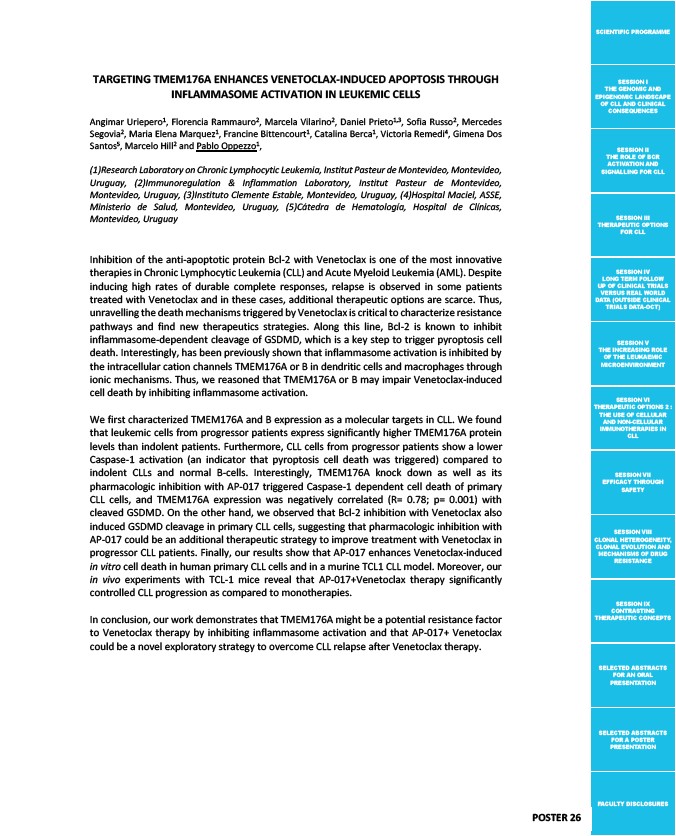
SCIENTIFIC PROGRAMME
SESSION I
THE GENOMIC AND
EPIGENOMIC LANDSCAPE
OF CLL AND CLINICAL
CONSEQUENCES
SESSION II
THE ROLE OF BCR
ACTIVATION AND
SIGNALLING FOR CLL
SESSION III
THERAPEUTIC OPTIONS
FOR CLL
SESSION IV
LONG TERM FOLLOW
UP OF CLINICAL TRIALS
VERSUS REAL WORLD
DATA (OUTSIDE CLINICAL
TRIALS DATA-OCT)
SESSION V
THE INCREASING ROLE
OF THE LEUKAEMIC
MICROENVIRONMENT
SESSION VI
THERAPEUTIC OPTIONS 2 :
THE USE OF CELLULAR
AND NON-CELLULAR
IMMUNOTHERAPIES IN
CLL
SESSION VII
EFFICACY THROUGH
SAFETY
SESSION VIII
CLONAL HETEROGENEITY,
CLONAL EVOLUTION AND
MECHANISMS OF DRUG
RESISTANCE
SESSION IX
CONTRASTING
THERAPEUTIC CONCEPTS
SELECTED ABSTRACTS
FOR AN ORAL
PRESENTATION
SELECTED ABSTRACTS
FOR A POSTER
PRESENTATION
FACULTY DISCLOSURES
TARGETING TMEM176A ENHANCES VENETOCLAX-INDUCED APOPTOSIS THROUGH
INFLAMMASOME ACTIVATION IN LEUKEMIC CELLS
Angimar Uriepero1, Florencia Rammauro2, Marcela Vilarino2, Daniel Prieto1,3, Sofia Russo2, Mercedes
Segovia2, Maria Elena Marquez1, Francine Bittencourt1, Catalina Berca1, Victoria Remedi4, Gimena Dos
Santos5, Marcelo Hill2 and Pablo Oppezzo1,
(1)Research Laboratory on Chronic Lymphocytic Leukemia, Institut Pasteur de Montevideo, Montevideo,
Uruguay, (2)Immunoregulation & Inflammation Laboratory, Institut Pasteur de Montevideo,
Montevideo, Uruguay, (3)Instituto Clemente Estable, Montevideo, Uruguay, (4)Hospital Maciel, ASSE,
Ministerio de Salud, Montevideo, Uruguay, (5)Cátedra de Hematología, Hospital de Clínicas,
Montevideo, Uruguay
Inhibition of the anti-apoptotic protein Bcl-2 with Venetoclax is one of the most innovative
therapies in Chronic Lymphocytic Leukemia (CLL) and Acute Myeloid Leukemia (AML). Despite
inducing high rates of durable complete responses, relapse is observed in some patients
treated with Venetoclax and in these cases, additional therapeutic options are scarce. Thus,
unravelling the death mechanisms triggered by Venetoclax is critical to characterize resistance
pathways and find new therapeutics strategies. Along this line, Bcl-2 is known to inhibit
inflammasome-dependent cleavage of GSDMD, which is a key step to trigger pyroptosis cell
death. Interestingly, has been previously shown that inflammasome activation is inhibited by
the intracellular cation channels TMEM176A or B in dendritic cells and macrophages through
ionic mechanisms. Thus, we reasoned that TMEM176A or B may impair Venetoclax-induced
cell death by inhibiting inflammasome activation.
We first characterized TMEM176A and B expression as a molecular targets in CLL. We found
that leukemic cells from progressor patients express significantly higher TMEM176A protein
levels than indolent patients. Furthermore, CLL cells from progressor patients show a lower
Caspase-1 activation (an indicator that pyroptosis cell death was triggered) compared to
indolent CLLs and normal B-cells. Interestingly, TMEM176A knock down as well as its
pharmacologic inhibition with AP-017 triggered Caspase-1 dependent cell death of primary
CLL cells, and TMEM176A expression was negatively correlated (R= 0.78; p= 0.001) with
cleaved GSDMD. On the other hand, we observed that Bcl-2 inhibition with Venetoclax also
induced GSDMD cleavage in primary CLL cells, suggesting that pharmacologic inhibition with
AP-017 could be an additional therapeutic strategy to improve treatment with Venetoclax in
progressor CLL patients. Finally, our results show that AP-017 enhances Venetoclax-induced
in vitro cell death in human primary CLL cells and in a murine TCL1 CLL model. Moreover, our
in vivo experiments with TCL-1 mice reveal that AP-017+Venetoclax therapy significantly
controlled CLL progression as compared to monotherapies.
In conclusion, our work demonstrates that TMEM176A might be a potential resistance factor
to Venetoclax therapy by inhibiting inflammasome activation and that AP-017+ Venetoclax
could be a novel exploratory strategy to overcome CLL relapse after Venetoclax therapy.
POSTER 26